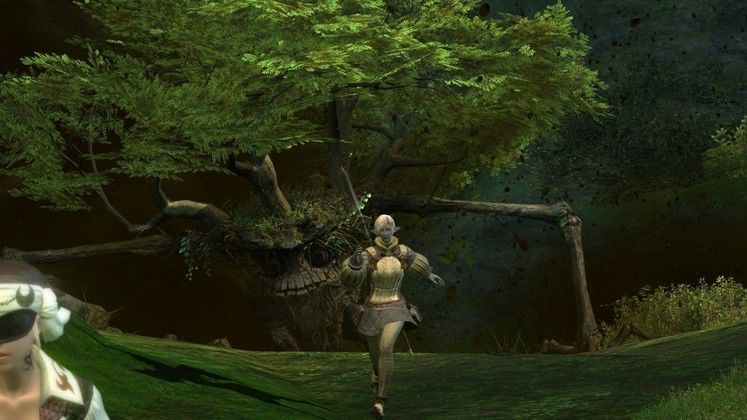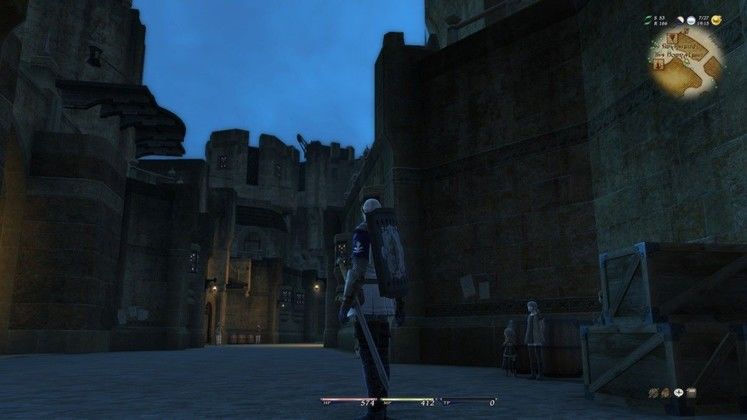Right from the start, it's fairly obvious that interface development was never high on the list of concerns. From the painfully over-complex signup process (it has to be experienced to be believed) to the lack of keyboard shortcuts and nests of in-game menus for even the simplest of commands, the PC release of XIV is marred by a clear focus on next year's PS3 iteration. Indeed, plugging in a controller and playing the game on its own terms is somewhat of a revelation; the menu system, sluggish character movement and targeting suddenly makes sense, and previously restrictive interactions are transformed through a logical interface. But this isn't a console; and given that the vast majority of people will play with a mouse and keyboard, such criticism is entirely warranted. Major patches are incoming, apparently.
 |
| It's a Spider! No, it's a tree! What? |
Leaving aside frustrations that may well be fixed by the time you read this, at least XIV's character creation system manages to leave a positive impression. Some way short of the complexity found in a City of Heroes but far advanced on the simplicity of WoW, the capable graphical engine renders figures with clean lines and some exquisite detail and facial animation. Each of the playable races are pleasant on the eye, with the graceful, tall Eleven sitting comfortably alongside the likes of the rather bizarre and miniature Lalafell. Texturing is excellent, lighting first-rate, shadowing believeable. It might be a little too pristine and model-like for some, but it feels like a logical aesthetic for Eorzea's rolling and verdant landscape.
For the most part, that positivity also transfers to each of the initial three city states that you can choose to home your avatar. Each is rendered with genuine style and detail, matched with a draw distance that occasionally staggers. Even on modest hardware (the reviewer played on a 1GB ATI 5750 paired with a 3Ghz Core 2 Duo), the results can be fantastic as long as you're prepared to fiddle with graphical menus (accessed solely outside the main executable). If you ever played Everquest 2 as a slideshow back in the day and wondered what it would look like in years to come on more prominent hardware, this is the game to make those images come to life - the similarities in both architecture and graphical design are uncanny at times.
But that noble veneer soon crumbles as you take your first steps off the ship. At first I was convinced Eorzea was actually my own personal ghost town, such was the lag in warping NPC characters into the environment. Framerate is superb and character movement responsive, then all of a sudden everybody else pops into view and the engine grinds to a halt. It's not as if this isn't a common problem in MMO-land of course, but the sheer scale of loading times make navigating crowded cities a crapshoot. What's worse is that the graphical and network lag transfers directly to the interface, making even simple tasks such as swapping out clothing an incredible chore. Finding a quiet spot or facing a wall usually helps, but the lack of polished performance is high even for a new MMO.
 |
| It all looks pretty damned nice |
Of course, that's assuming you've figured out how to get yourself some new duds in the first place. Surprisingly as it's heading to a console crowd next year, Square has seen fit to annex almost any semblance of accessible tutorial. The first story quest introduces you to a few key characters and provides a quick guided tour of your chosen city's guilds and services, but the entire thing is buried in dull text that's frequently hidden away in the chat window. Non-interactive cutscenes provide a brief dash of innovation, but nothing about the game's structure is easy to find or interpret. The map fails to mark out several key features in each city and skips crucial information such as quest-givers or the location of a player-run marketplace, and even if you do stumble across people willing to sell you items (there is no auction house), viewing their inventory is a protracted and painful experience.
Questing follows a similar path of baffling design and over-complication, with the controversial "Guildleve" system replacing the majority of content that would be found through exploration and NPC interaction in other titles. Broadly speaking, Guildleves are the meat of the experience and take the form of specific task-cards issued by specific level-appropriate NPCs in each city (and later elsewhere). There are only a few selectable at any time (broken into combat, crafting, gathering and later on guild-specific), and each has to be activated on a battlefield crystal that serves as a hub for travel and respawning. Only one of these tasks can be active at any time, and they mostly ask you to kill or harvest a set number of mobs or nodes within a 30-minute period. Rinse, repeat, level.
By reducing the majority of its content to a series of tasks picked up singular locations, Final Fantasy XIV inevitably shifts its focus onto a grind - at the expense of those few storyline moments that show a slight willingness to play with the formula. Indeed the story-based quests undoubtedly turn out to be the highlight of the entire package, as the design often generates unique instances and scenarios that open your character to a level of character involvement that's missing elsewhere. There isn't anything to those moments that'll blow your mind if you've played any RPG of the last few years however, and the fact the best world-building material actively steps you away from the multiplayer components of Square's universe is extremely telling.
Outside of those, if there are any redeeming features to make the grind worthwhile, they certainly lie within a unique levelling system that frankly I'd expect to be better implemented in other MMO's down the line. FFXIV contains three separate XP bars to keep an eye on: one for your crafting profession; one for your combat class; and an overall 'physical' meter that amalgamates experience from both to unlock assignable stat points. The genius here comes from of combat and crafting professions that are essentally hot-swappable. As an example, if you level up your skills as an archer and get bored, you can just change out your weapon for a sword and begin again, instantly changing your combat style to whatever you'd like it to be. Skills unlocked through any class are available no matter what equipment you choose, so if you wanted to mix and match your hotbar abilities from different professions, you're completely free to do so.
 |
| If only it played as well |
It's a great system in practice, and one that offers up a level of freedom quite unmatched by the other titles of the moment. Equipment follows suite, with armour and most weaponry actively scaling to your level, making even the cool costumes available to relative peons - provided they can find them and have the means to purchase. The community itself is also fairly varied with a good mix of solo crafters, guilds and adventurers wandering around and going about their business. Once the character models have loaded and the stars aligned to allow semi-decent performance, the bustling cities in Eorzea can become fairly compelling places to simply explore, which is a pleasant diversion amidst a sea of adequacy elsewhere.
But those moments are fleeting, and tantalising at best. Even if you spend the time to unlock your skills and build that warrior-archer-tank-damager behemoth you had in mind, what's the point if the activities you're engaging in are so threadbare and unappealing for the most part? It's a problem that Square can go some way to fixing with post-launch content updates and dramatic technical overhauls, but given the frailty of any online community within those crucial first few months, you have to wonder if they'll ever get the chance. Here's hoping they do, because nobody wants to see Eorzea limping along in its current form, and least of all those of you waiting for the upcoming PS3 release. Much work is ahead.
Best Game Moment:
FINAL FANTASY XIV: A REALM REBORN VERDICT
Finally figuring out a direction for your character




